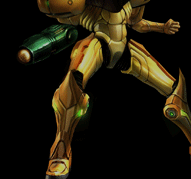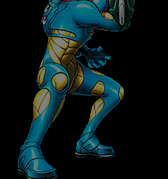This interview originally appeared in Nintendo Dream vol. 85 (March 2003), but was republished on the official Metroid Prime & Fusion website in their interview section in collaboration with Nintendo Dream. These interviews have never been translated until now, and are available exclusively at the Metroid Database!
| — | By the way, what is Metroid for you, Sakamoto-san? |
| Sakamoto |  Since a lot of people were cheering enthusiastically while we were making this game, [the series] is highly respected, and is also extremely popular overseas, so it’s like my personal experience concerning the teamwork we made the game with. After the Famicom version, the Game Boy version came out (1992). Although at that time I was not involved at all, I had a strong feeling that I wanted to express the protagonist Samus as a living person, and so after that I made the Super Famicom version (1994), and so of course after that Fusion is also connected to this. Therefore, what Metroid is to me is a story of Samus as a human being and its status as a product. What I mean by that is I think it [the series] will never end. Since a lot of people were cheering enthusiastically while we were making this game, [the series] is highly respected, and is also extremely popular overseas, so it’s like my personal experience concerning the teamwork we made the game with. After the Famicom version, the Game Boy version came out (1992). Although at that time I was not involved at all, I had a strong feeling that I wanted to express the protagonist Samus as a living person, and so after that I made the Super Famicom version (1994), and so of course after that Fusion is also connected to this. Therefore, what Metroid is to me is a story of Samus as a human being and its status as a product. What I mean by that is I think it [the series] will never end. |
| — | And where will it continue from here? |
| Sakamoto | I want it to continue if I can make it continue. Beyond that, I want to focus on Samus as a character. I hadn’t followed up on this due to the games I’ve been involved with. |
| — | What is Metroid to you, Tanabe-san? |
| Tanabe | Thus far, it’s a game I’ve looked at objectively. While we are both at Nintendo, since we have different positions and I’ve just seen products from R&D1, I think that’s why I’ve never been involved in any of these titles. Because of that, since it was about one year after the Disk version came out that I entered the company, this was a period where I had a strong sense of playing games rather than making them, so it’s a game that’s very dear to me. |
| — | What about you, Yamamoto-san? |
| Yamamoto | I entered R&D1, and my biggest work was Super Metroid. After I made Famicom Detective Club with Sakamoto, although we’ve been doing lots of work together, if you mean the very first Metroid, Hirokazu Tanaka-san was in charge of it, and since I have memories of working together with Tanaka-san in those days [They both collaborated on Famicom Wars -ed.], I feel my memories of R&D1 are completely packed with games. |
| — | You also remember team members you worked with in those days. |
| Yamamoto | That’s right. Therefore, even when I began this work, I remembered the sheer hell with Sakamoto during Super Metroid. (Laughs) |
| Sakamoto | That was a disaster. Although you might have heard the rumors, we couldn’t go home, and since we worked on Super Metroid every day and night, people openly said, “I just don’t want to do this!” (Laughs) |
| Everyone | Roars with laughter |
| Tanabe | You never told me that before! (Laughs) However, didn’t everyone in R&D1 work on that game? Therefore, you would go to the development building’s cafeteria, and everybody from R&D1 was in there. |
| Sakamoto | In those days, we worked in the room beside the president’s office. However, I think everyone worked on debug, and almost everybody worked together closeby. |



